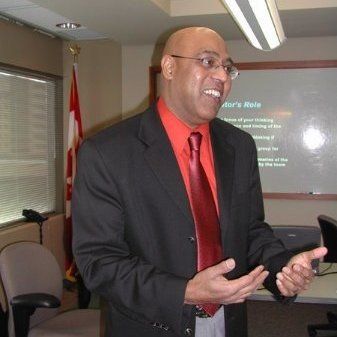Intentional Leadership: Connecting the Head, Heart, Hands, and Holy

Soon, Christians around the world will once again be celebrating Easter. Historically, we learned that this Christian festival of Pascha (Easter) began to appear since the mid-2nd century. In the Christian faith, Easter is the climax of the trial, crucifixion, death, and resurrection of one man. In this article, I want to focus on the person who lies at the heart of the Christian faith: Jesus of Nazareth.
While Christian believers accept Jesus as both man (humanity) and the Son of God (divinity), in this article I want to focus on his humanity and how he embodied leadership – intentionally. So, to clarify, this is not a theological piece, and let me ask for forgiveness from Christians as I focus on the humanity of Jesus.
At the same time, in our secular and multiconfessional world, this reflection piece is not intended to ‘peddle Christianity’. Instead, it is meant to be a reflection of critical leadership lessons that we can learn from this man.
My story is that Jesus of Nazareth teaches us to pay attention to the fundamental work of leadership as a relationship among the 4 H’s: the Head, Heart, Hands, and Holy. I began thinking about this reading the last line in Kouzes & Posner’s (2017) text, The Leadership Challenge. They concluded their well-researched and written book with these two sentences:
Leadership is not an affair of the head. Leadership is an affair of the heart
I beg to differ. I believe intentional leadership is both an affair of the head and the heart, but additionally an affair of the hands and the holy.
What do I mean? Easter represents a new beginning, an opportunity for us to think of leadership in a new way. An opportunity for us to renew our thinking of leadership as an interconnected relationship among all 4 H’s.
Part of the problem that we face in our leadership thinking today, is that we have compartmentalised our thinking when the reality is that everything is interconnected.
Intentional Leadership: The Head
As he walked along the streets in his time, Jesus communicated directly and indirectly not only to the religious authorities of the period, but also to all who would listen.
Indirectly, he used parables to communicate his message. He was a storyteller par excellence. Through his parables, he masterfully helped his listeners discover the deeper meaning and underlying truth of the reality he portrayed. Through his storytelling and parable telling he offered his listeners an opportunity to intentionally pay close attention to what was important, to what was going on around them and in their own hearts.
At the same time, he did not shy away from directly addressing the hypocrisy of those in positions of authority. History has shown us that the best leaders are often great storytellers.
Indirect Communication
Jesus was once tested by an expert of the law with the question: “What must I do to inherit eternal life?”
He responded first by asking the questioner to tell him what was written in the law. Even though Jesus affirmed that the expert answered correctly (‘Love your neighbour as yourself”), the latter was still not satisfied. He pushed Jesus to answer the question: “Who is my neighbour?” This prompted Jesus to tell his story of the Good Samaritan (See Luke 10:25-37).
It is revealing to note his choice of using the Samaritan as exemplifying leadership. The Samaritans were half-Jew and half-Gentile. The Jews chose not to have any dealing or relationship with the Samaritans. They were treated with prejudice like Hermione from Harry Potter, as ‘mudbloods’, or impure – again a pejorative term.
And yet, in response to the question asked, Jesus, who was himself of Jewish heritage (who dislike Samaritans), chose to tell a story about the Good Samaritan. It was a story about a man who had been robbed, beaten, and left behind half dead. While two men, a priest and a Levite (both Jews) chose to pass this man on the other side, a Samaritan took pity, bandaged his wounds, brought him to an inn and took care of him.
When this law expert was asked: “Which of these three do you think was a neighbour to the man who fell into the hands of robbers?” he replied, “The one who had mercy on him.”
In intentional leadership from the head, Jesus of Nazareth intentionally distinguishes between following the law (Rules-Based Leadership) and acting mercifully (Principles-Based Leadership). If one’s agenda is to be rewarded, then Jesus appears to be saying, that following the rules, and being compliant with established instructions, may be sufficient.

However, this story raises the bar of what it means to be neighbourly. In our world of much violence, this story reminds us that we are all called to live in ways that care for each other. This is a tall order because it also challenges us to extend our neighbourliness to those who may have robbed or caused us harm (including people we may detest).
Jesus of Nazareth flips the script, whereas vengeance may be a natural human response to hate, mercy and love are counterintuitive.
Direct Communication
Jesus of Nazareth, however, did not only speak in terms of parables. In fact, he infuriated the religious establishment of his day with the use of very strong, direct, and unflattering language. In Matthew 23, for example, we read about his criticism of the ‘hypocrisy’ of the teachers of the law and the religious leaders.
…’quietism‘ today which during a more pious age was called ‘the sin of silence‘,” costs organisations – their leaders and followers – dearly
He goes further and calls them ‘blind guides,’ ‘straining out gnats but swallowing camels’, ‘snakes’, and a ‘brood of vipers’, and of being ‘like whitewashed tombs that look handsome on the outside, but inside are full of dead men’s bones and every kind of corruption‘.
These are not terms of endearment. In fact, these are combative words. In the face of hypocrisy, this man called Jesus had no patience for those who were in positions of power, and who, in their arrogance and convulsive sense of self-importance, refused to learn or care for others. He had no patience for those who were too busy listening to their own voices.
Is it any wonder that the religious authorities at his time were hell-bent on getting rid of him? What a sharp thorn he must have been! How about us? As leaders, do we give real feedback when necessary, or are we afraid to tell the truth?
Speaking directly and using such harsh words without any sugar-coating, runs the risk of forcing reactions rather than conversations. But would sugar-coating, in this context, not be like another form of coddling or pandering? Jesus’ intentional use of his language resided in his courage to risk the consequences of being direct because it was necessary to break patterns that connect silent collusions and practices of ‘playing nice’.
In recent times, Warren Bennis, a leadership guru, pointed out that ‘quietism‘ today which during a more pious age was called ‘the sin of silence‘,” costs organisations – their leaders and followers – dearly. It is not accidental then to hear Pope Francis openly outlining 15 leadership diseases confronting his own executive team – the Roman Curia.
In his 2014 Christmas Address, for example, he directly noted that the most serious disease challenging his priestly executive team is existential schizophrenia. This is a disease of those who live a double life. It is a disease of losing contact with reality. It is a disease of saying or teaching one thing but doing and behaving in another way.
Intentional Leadership: The Heart
James McGregor Burns, a reputed leading authority on Leadership Studies, suggests the essential purpose of leadership is to influence people to be aware of what they feel so that they can be moved to purposeful action. Why go to the level of ‘feelings’?
Because where nothing is felt, nothing matters. In reflecting and writing on the pain and glory of industrialisation, we also hear political theorist Karl Marx asking: ‘But although the atmosphere in which we live weighs upon everyone like a 20,000 lb. force, do you feel it’?
Is the heart not the place that is associated with ‘feelings’?
Returning to Jesus of Nazareth, he was very clear on his mission and purpose early on in his youth. He felt it deeply in his heart. As a young man, he caught the attention of many with his clarity. Entering the place of worship, he was given a scroll of the Prophet Isaiah.
As the story unfolds, he unrolled the scroll and intentionally looked for the place where the following was written: “He sent me to bring the good news to the poor, to proclaim liberty to the captive…to the blind new sight…” And as embodied in the story of the Good Samaritan, that is exactly how he sought to live his life.
To lead with heart, is first and foremost to focus on ‘a higher purpose.’ It is not a matter of doing what is only best for oneself. And it is not a question of being leader-centric but rather mission or purpose centric. Perhaps it is this that motivated Pope Francis to ‘dream of a missionary option’ and not one that is dictated by rules and instructions.
Intentional leadership with a focus on his higher purpose gave Jesus the passion to ignite the fire in others and move them to higher levels of morality and motivation.
In a 2003 Harvard Business Review’s conversation with Robert McKee, the author of his best-selling book Story: Substance, Structure, Style, and the Principles of Screenwriting, McKee advised CEOs who seek to motivate others to reach certain goals to first ‘forget about PowerPoint and statistics.’
He advised them instead to ‘involve people at the deepest level’ by telling a compelling story. “In a story,” he said, “you not only weave a lot of information into the telling, but you also arouse your listener’s emotions and energy.”
He further noted that stories “fulfill a profound human need to grasp the patterns of living – not merely as an intellectual exercise, but with a very personal, emotional experience.”
Similarly, acclaimed Native American novelist and poet, Leslie Marmon Silko, also concurs. She noted in the epigraph of her book Ceremony: “I will tell you something about stories…They aren’t just entertainment. Don’t be fooled … You don’t have anything if you don’t have stories.”
Heartful stories are a powerful way to connect with what matters most. It is a way of arousing emotions and energy to feel the need to begin anew and not to be stuck with the same old, same old.
Heartful stories can come in many forms. Art, poetry and music can also touch our hearts in ways that we might not have imagined. We need, however, to be extremely careful. Stories can (and have) also be used to stir up anger and resentment. They can be used to destroy. They can be used to mislead. They can be used to divide neighbour from neighbour, to make them fight and compete against one another. Our stories – that which we choose to remember and tell – can, as psychologist Miller Mair noted, ‘hold us together’ or ‘keep us apart’.
The Hands
For me, ‘leading with hands’ is a metaphor for acting on one’s mission or purpose. The story of the Good Samaritan is a story of seeing what needs to be done, feeling the need to do something about it, and doing it.
It is to be moved to purposeful action. Insofar as Jesus embraced his purpose and mission, we read over and over that he intentionally reached out to the socially marginalised. These included, among others, conversing with people hated by society including tax-collectors, prostitutes, having meals with those who were considered ‘unclean,’ and reaching out to lepers.
Purpose without action is simply wishing for something to happen. At the same time, acting on one’s purpose does not necessarily translate into achieving what one intended. Actions can be derailed. As Hannah Arendt, a political theorist says, ‘it lies in the boundlessness of actions’.
There may also be unintended consequences of one’s actions. And those consequences may be irreversible. It is not accidental then to hear that the road to hell is filled with good intentions. And I might add: it is also filled with bad intentions.
This, however, is what it means to act. It is like throwing a stone. We are unable to reverse that stone while it is in mid-air. To act is to accept the boundlessness and unpredictability of achieving what was intended. But to not act, means we will not achieve. As leaders, are we acting? Are we executing?
The Holy
…If you keep silent, keep silent by love: if you speak, speak by love; if you correct, correct by love; if you pardon, pardon by love; let love be rooted in you, and from the root nothing but good can grow. Love and do what you will. – Augustine of Hippo
The call to holiness is generally believed to be limited to messages that come from religious sources. We falsely believe that holiness is only for those who withdraw from ordinary affairs and spend much time in solitary prayer, like monks.
For Pope Francis, however, this is not the case. In his Call to Holiness in Today’s World, he shared that “we are all called to be holy by living our lives with love and by bearing witness in everything we do, wherever we find ourselves.”
Within the context of the parable of the Good Samaritan, we could also construe the call to holiness as a call to love our neighbours. While ‘love’ might not be a word that is readily used today, it is revealing to note that after studying leadership for over thirty years, Kouzes & Posner, in the same text noted earlier, were constantly reminded about how many leaders use the word love freely talking about their own motivations to lead.
I would suggest that the holiness of treating one’s neighbours with mercy and love, is to suggest that there are some things that are sacred. Treating one’s neighbours with mercy and love, in other words, is non-negotiable.
They cannot be treated the same way we treat things that can be sold, exchanged, or replaced. We simply do not treat our neighbours or people as ‘things.’ We don’t, for example, annex their lands for our own purposes.
Let me turn again to Karl Marx. With the ‘progress’ of industrialisation, he also laments the fact that ‘all that is holy is profaned’ and that ‘all that is solid melts into air’. To profane the holiness of treating our neighbours with love and compassion is to practice injustice towards our fellow human beings. It is to be disrespectful of our neighbours.
What is non-negotiable in this story of the Good Samaritan is that we need to understand (believe) that we are all in this together. It is a world of solidarity, not discord. It is a world of neighbours respectfully looking out for and caring for neighbours. And what makes this principle extremely challenging, as I noted earlier, is that this principle also includes responding to those who have caused us harm with mercy and love.
We can take heart in what Augustine of Hippo said: “If you keep silent, keep silent by love: if you speak, speak by love; if you correct, correct by love; if you pardon, pardon by love; let love be rooted in you, and from the root nothing but good can grow. Love and do what you will.”
Conclusion
I would like not to conclude but rather to invite all to embrace the fundamental leadership message of Easter, namely, to begin anew – intentionally. While Easter would not be Easter without the trial, crucifixion, death and resurrection of Jesus, his message appears to not give death the last word. The message of Easter is that we are to begin or start something new. To love people and show it by our head, hands, heart and holiness.
In my storying of Easter’s message, I am proposing a new conceptual leadership framework, namely that we think, talk, and practice leadership from the perspective of the interconnectedness and the interweaving of the relationship between and among the 4 Hs.
What would any of the four Hs be, without the other? Would it not simply be a matter of leading from the ‘gut’? And we do know that biologically the gut is the place where the human body gets rid of toxic waste.
Happy Easter, my dear reader.
Functional





